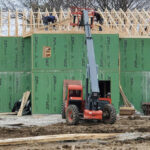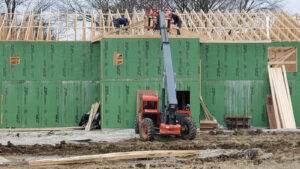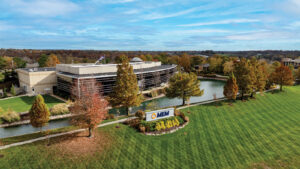The Chamber of Commerce, until this June, had a flooding problem. Last winter, employees noticed water seeping through the Walton Building’s decaying siding, and the boardroom routinely flooded. Water cleanup sometimes preceded meetings. Inspectors found a gaping hole in the attic walls. The building’s windows, some of which came with original construction in 1986, no longer met sealing standards. a building improvement was in order.
Throughout the process of funding and scheduling the repairs, which took most of the spring, the chamber was busy making other improvements: developing and drafting their strategic plan, an outline of goals and objectives to guide chamber policy until 2018. The strategy, unveiled to chamber members at their annual awards banquet on June 18, refocuses the strategy last out-lined seven years ago. The new siding seems timely, as it echoes the strategy’s first listed objective: “Rebrand business to the community.”
Own your message
The strategic restructuring began without planning in May 2012, when Chamber of Commerce President Don Laird announced he would retire the following January, after 24 years in his position. The announcement wasn’t a surprise — Laird was past retirement age — but resources had to be mobilized quickly. The chamber recruited an outside agency, Organizational Dynamics, to work with a chamber search committee and find a new president. The result: Current President Matt McCormick, who was recruited to Columbia from a president position in a Dallas suburb, helped design the new strategic plan.
Before the searching began, however, the search committee took stock of their organization; to find a good fit, they had to find out what the fit was.
The committee polled current and former chamber members, reviewed internal policy and tried to determine what they needed. Initially, this was all done with the goal of finding a president, but once McCormick came on board, the snowball had started rolling. The chamber kept looking to improve, and they ordered an internal audit.
The auditors wanted to trim fat: the 2013-2014 annual Report from the chamber says the process reviewed all chamber functions to “determine if they continued to be consistent with our mission, were productive and cost efficient.”
Heather Hargrove, whose term as chair of the board of directors ended in June, says the audit revealed both strengths and shortcomings: one shortcoming being communication, which is addressed in the first and last of the strategic plan’s five “pillars.”
“So, how do we better tell our strengths?” Hargrove asks. “We’re trying to be the voice of business. That captures so much of what we’re trying to do with these five pillars. We want to tell our own story rather than have somebody else tell it for us.”
Creating sound structure
The five pillars are: be the voice of business, deliver value to members, advance community excellence, support sustainable economic development and develop organizational sustainability. each pillar has its own subset of goals and objectives.
The plan is, as McCormick says, a strategic communication outline, one with concrete steps and emphasis on specific chamber initiatives. a quick read reveals a few general themes, such as more directed influence on business policy and solidified organizational structure, but the plan is ultimately about ensuring future success. The chamber is a nonprofit organization, and most revenue comes from membership dues and fundraising.
The well-being of the chamber, therefore, depends on how much success it creates for local business. There’s strong incentive to make sure the chamber is effective.
The strategic plan addresses the problem in a handful of ways: In addition to clarifying external communications, the plan calls for a refocus of influence in local and state politics, the hiring of durable and successful chamber staff and improving coordination with local business resources such as RedI and MU-based incubators.
“I don’t know if it’s so much about the change in economic development but the struggle in economic development,” Hargrove says. “It’s become quite stagnant, and frankly, we can’t hang our hats on IBM forever. That’s still where we are. There’s a challenge in this city for economic development.”
“We think it’s our responsibility, in terms of the business community, to provide strong leadership,” says Kit Stolen, who replaced Hargrove as chair in June. “We’re collaboratively trying to figure out what the best avenues are for the community.”
The long term
McCormick says they want to see another success like veterans United, the home loan agency founded in Columbia in 2002 that has since grown to 1,400 employees nationwide. Such success stories, he says, reflect Columbia’s spirit of entrepreneurship, and the chamber wants to ingratiate itself early in that process.
Likewise, Stolen says the new plan is about weaving business into the fabric of the community. Again, the theme of long-term growth and stability comes up, with Hargrove saying, “I think one of the key words to stress is planning — the future.”
“We do think the city focuses on episodic events a lot,” Stolen says. “We’d love to see a bias of focus toward long-term planning.”
“What’s crazy to me,” Hargrove adds, “is how it’s all connected. When you have a strong economic development foundation in your community, that keeps people working and financially able to support themselves and their families, and that, in turn, pays the taxes that support the parks everyone loves. It’s all interconnected. If we’re not having economic development, the rest of that stuff starts to stall as well.”
McCormick nods. “Planning is the key,” he says, “and it’s not episodic, and it’s not just one group making the plan. It’s a collaborative effort.”
“It has to be,” Stolen adds.
“And it’s that long-term planning to know where we’re going so we can hopefully stop having the long discussions and the arguments over this episode and that episode and to make sure we’re all pulling in the same direction,” McCormick says.
“To be proactive rather than reactive,” Hargrove says.
The fifth pillar, develop organizational stability, is internally focused. It calls for a sleeker chamber: one that is able to quickly adapt to new challenges and new opportunities.
When asked what most excites them about the new plan, McCormick, Hargrove and
Stolen all say leadership, both within the chamber and in the community. It’s the last objective listed in the new strategic plan, and it’s one that is noticeably missing from the 2007 version: continue strategic leadership.
Repairs to the Walton Building, they hope, will be the least significant improvements the chamber makes this year.









